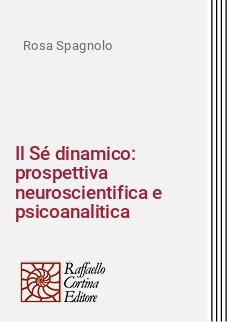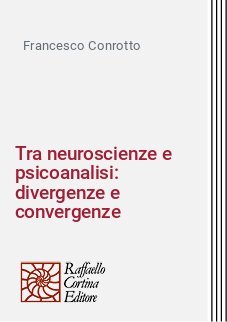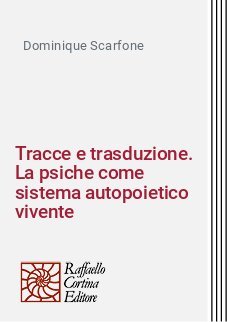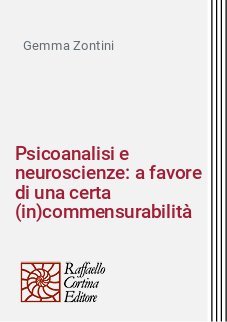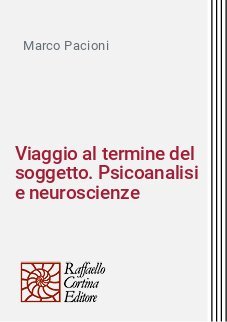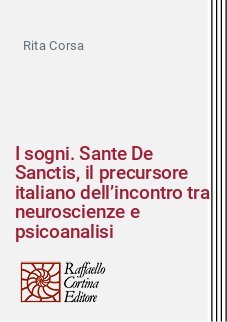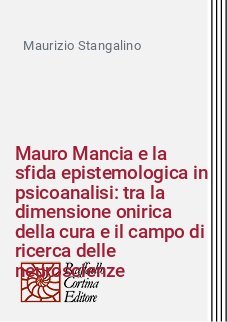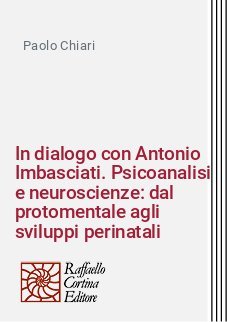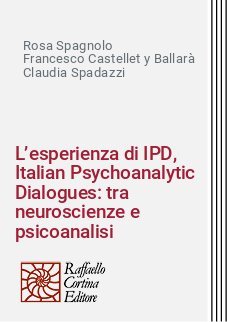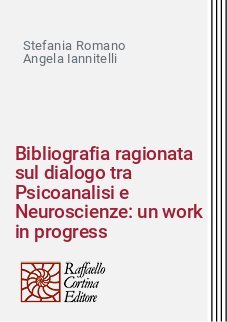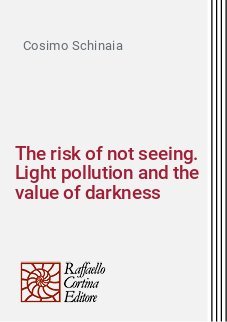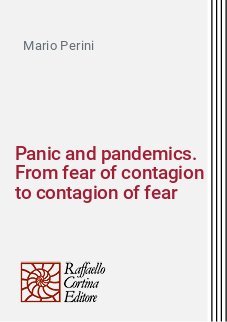Raffaello Cortina Editore
Il Sé dinamico: prospettiva neuroscientifica e psicoanalitica
rivista: La Rivista di Psicoanalisi
fascicolo: Rivista di Psicoanalisi 2023/3
di Rosa Spagnolo
Il Sé dinamico: prospettiva neuroscientifica e psicoanalitica
I modelli psicoanalitici e neuroscientifici che indagano la relazione mente-cervello includono lo studio della relazione Sé/altro/mondo. Nella sua continuità-discontinuità, il Sé rappresenta il collante soggettivo che informa la nostra esistenza; è caratterizzato da una «durata estesa» in cui il passato persiste nel presente e influenza il futuro. Il Sé è incorporato e allineato al suo rispettivo ambiente temporo-spaziale e si adatta al mondo attraverso questo allineamento temporo-spaziale. Pertanto, il Sé non è incapsulato nella mente, né si basa solo sul nostro corpo, ma si estende oltre la mente e il corpo, includendo il mondo. Senza questa costruzione dinamica spazio-temporale, il Sé apparirebbe discontinuo e frammentato.
Parole chiave: Neuroscienze, psicoanalisi, Relazione Sé-Altro, Sé dinamico, Self continuity, Self embodiment.
The dynamic self: Neuroscientific and psychoanalytic perspective. Psychoanalytic and neuroscientific models investigating the mind-brain relationship include the study of the Self/other/world relationship. In its continuity-discontinuity, the Self represents the subjective glue that informs our existence; it is characterized by an «extended duration» in which the past persists in the present and influences the future. The Self is embedded in and aligned with its respective temporo-spatial environment and adapts to the world through this temporo-spatial alignment. Therefore, the Self is not encapsulated in the mind, nor is it based only on our body, but extends beyond the mind and body to include the world. Without this dynamic space-time construction, the Self would appear discontinuous and fragmented.
Keywords: Dynamic self, neurosciences, psychoanalysis, Self continuity, Self embodiment, Self-Other relationship.
Le soi dynamique: perspective neuroscientifique et psychanalytique. Les modèles psychanalytiques et neuroscientifiques qui étudient la relation esprit-cerveau incluent l’étude de relation soi/autre/monde. Dans sa continuité-discontinuité, le Soi représente le ciment subjectif qui éclaire notre existence; il se caractérise par une «durée prolongée» dans laquelle le passé persiste dans le présent etinfluence l’avenir. Le Soi est intégré et aligné avec son respectif environnement temporo-spatial et s’adapte aumonde à travers cet alignement spatio-temporel. Par conséquent, le Soi n’est pas encapsulé dans l’esprit, et il n’est pas basée uniquement sur notre corps: il s’étend au-delà de l’esprit et du corps pour inclure le monde. Sans cette construction dynamique de l’espace-temps, le Soi apparaîtrait discontinu et fragmenté.
Mots-clés: Neuroscience, psychanalyse, relation Soi-Autre, Soi dynamique, Self continuity, Self embodiment.
El Self dinámico: perspectiva neurocientífica y psicoanalítica. Los modelos psicoanalíticos y neurocientíficos que investigan la relación mente-cerebro incluyen el estudio de la relación Self/otro/mundo. En su continuidad-discontinuidad, el Self representauna especie de ligazónsubjetivo que informa nuestra existencia. Se caracteriza por una «duración prolongada» en la que el pasado persiste en el presente e influye en el futuro. El Self está integrado y alineado con su respectivo entorno temporo-espacial y se adapta al mundo a través de esta alineación temporo-espacial. Por lo tanto, el Self no está encapsulado en la mente, ni se basa únicamente en nuestro cuerpo, sino que se extiende más allá de la mente y el cuerpo, incluido el mundo. Sin esta construcción dinámica espacio-temporal, el Self parecería discontinuo y fragmentado.
Palabras clave: Neurociencias, psicoanálisis, Relación Self-Otro, Self Dinámico, Self-Continuity, Self-Embodiment
Das dynamische Selbst: Eine neurowissenschaftliche und psychoanalytische Perspektive. Die psychoanalytischen und neurowissenschaftlichen Modelle, die das Verhältnis Geist-Gehirn untersuchen, umfassen zugleich die Erforschung des Verhältnisses Selbst/Anderer/Welt. In seiner Kontinuität-Diskontinuität stellt das Selbst das subjektive Bindemittel dar, das unserer Existenz zugrundeliegt; es zeichnet sich durch eine ‚gedehnte Dauer‘ aus, in der die Vergangenheit in der Gegenwart fortbesteht und die Zukunft beeinflusst. Das Selbst ist eingefügt in und ausgerichtet auf seine jeweilige zeitlich-räumliche Umgebung und passt sich durch diese zeitlich-räumliche Ausrichtung an die Welt an. Daher ist das Selbst weder im Geist eingekapselt, noch basiert es ausschließlich auf unserem Körper, sondern erstreckt sich über Geist und Körper hinaus und schließt die Welt mit ein. Ohne diese dynamische raumzeitliche Konstruktion erschiene das Selbst diskontinuierlich und fragmentiert.
Schlüsselwörter: Dynamisches Selbst, Neurowissenschaft, Psychoanalyse, Self continuity, Self embodiment, Verhältnis Selbst-Anderer.
Tra neuroscienze e psicoanalisi: divergenze e convergenze
rivista: La Rivista di Psicoanalisi
fascicolo: Rivista di Psicoanalisi 2023/3
di Francesco Conrotto
Tra neuroscienze e psicoanalisi: divergenze e convergenze
La scienza contemporanea ritiene che l’osservazione modifichi l’oggetto osservato. Pertanto l’analista nel suo lavoro modifica la situazione del paziente da lui osservato. Se questo è valido nella scienza possiamo dire che tra psicoanalisi e scienza vi sia una possibile convergenza. La conoscenza è sempre influenzata dalla soggettività del soggetto conoscente. Essa è prodotta da funzionamenti elettrici cerebrali che rispondono anche al principio di piacere. Pertanto la conoscenza non è solo il prodotto di processi razionali e logici ma ci sono anche fattori affettivi.
Parole chiavi: Neuroscienze, Psicoanalisi, presentazione, rappresentazione, significantizzazione, teoria dei quanta, trasduzione.
Between neuroscience and psychoanalysis: divergences and convergences. Contemporary science believes that observation modifies the observed object. Therefore the analyst in his work modifies the situation of the patient he is observing. If this is valid in science we can say that there is a possible convergence between psychoanalysis and science. Knowledge is always influenced by the subjectivity of the knowing subject. It is produced by electrical brain functioning that also responds to the pleasure principle. Therefore knowledge is not only the product of rational and logical processes but there are also affective factors.
Keywords: Neuroscience, Psychoanalysis, presentation, quantum theory, representation, signification, transduction.
Entre neurosciences et psychanalyse: divergences et convergences. La science contemporaine estime que l’observation modifie l’objet observé. C’est pourquoi l’analyste dans son travail change la situation du patient qu’il observe. Si cela est valable en science, nous pouvons dire qu’il y a une convergence possible entre la psychanalyse et la science. La connaissance est toujours influencée par la subjectivité du sujet connaissant. Elle est produite par des fonctionnements électriques du cerveau qui répondent également au principe de plaisir. La connaissance n’est donc pas seulement le produit de processus rationnels et logique, mais il y a aussi des facteurs affectifs.
Mots clés: Neurosciences, Psychanalyse, présentation, représentation, significantisation, théorie quantique, transduction.
Entre neurociencias y psicoanálisis: divergencias y convergencias. La ciencia contemporánea sostiene que la observación modifique el objeto observado. Por tanto el analista, en su trabajo, modifica la situación del paciente que observa. Si esto es válido en la ciencia podemos decir que existe una posible convergencia entre psicoanálisis y ciencia. El conocimiento siempre está influenciado por la subjetividad del sujeto cognoscente. Es producido por funciones eléctricas cerebrales que también responden al principio de placer. Por lo tanto el conocimiento no es sólo producto de procesos racionales y lógicos sino que también existen factores afectivos.
Palabras clave: Neurociencias, psicoanálisis, presentación, representación, significación, teoría cuántica, transducción.
Zwischen Neurowissenschaften und Psychoanalyse: Divergenzen und Konvergenzen. Die zeitgenössische Wissenschaft ist der Auffassung, dass die Beobachtung das beobachtete Objekt verändert. So verändert der Analytiker in seiner Arbeit die Situation des von ihm beobachteten Patienten. Wenn dies in der Wissenschaft gilt, können wir sagen, dasszwischen Psychoanalyse und Wissenschaft eine mögliche Konvergenz besteht. Die Erkenntnis ist immer von der Subjektivität des erkennenden Subjektsbeeinflusst. Diese ist Ergebnis elektrischer Hirnfunktionen, die auch auf das Lustprinzip antworten. Daher ist die Erkenntnis nicht nur Ergebnis rationaler und logischer Prozesse, sondern es gibt auch affektive Faktoren.
Schlüsselwörter: Neurowissenschaften, Psychoanalyse, Präsentation, Repräsentation, Signifizierung, Quantentheorie, Transduktion.
Tracce e trasduzione. La psiche come sistema autopoietico vivente
rivista: La Rivista di Psicoanalisi
fascicolo: Rivista di Psicoanalisi 2023/3
di Dominique Scarfone
Tracce e trasduzione. La psiche come sistema autopoietico vivente
L’Autore sostiene che in luogo di un discutibile rapporto diretto tra neuroscienze e psicoanalisi, si può ricorrere allaTeoria dei sistemi autopoietici, compatibile con entrambe le discipline e intermedia tra di esse. L’Autore mostra quindi la congruenza tra la Teoria dei sistemi autopoietici, il modello traduttivo della mente di Freud e di Laplanche, la linguistica di de Saussure e il concetto di individuazione attraverso quello di trasduzione di Simondon. Il concetto di trasduzione, inoltre, serve a risolvere un apparente problema con il modello traduttivo di Laplanche.
Parole chiave: Neuroscienze, psicoanalisi, traduzione, trasduzione, traccia.
Traces and transduction. The psyche as a living autopoietic system. The author argues that instead of a questionable direct relationship between neuroscience and psychoanalysis, autopoietic systems Theory, compatible with both disciplines and intermediate between them, can be used. The author thus shows the congruence between theTheory of autopoietic systems, Freud’s and Laplanche’s translational model of the mind, de Saussure’s linguistics and Simondon’s concept of individuation through transduction. The concept of transduction also serves to resolve an apparent problem with Laplanche’s translational model.
Keywords: Neuroscience, psychoanalysis, translation, transduction, trace.
Traces et transduction. Le psychisme comme système autopoïétique vivant. L’auteur soutient qu’au lieu d’établir une relation directe discutable entre les neurosciences et la psychanalyse, on peut recourir à la Théorie des systèmes autopoïétiques, compatible avec les deux disciplines et intermédiaire entre elles. L’Auteur montre donc la congruence entre la Théorie des systèmes autopoïétiques et le modèle traductif de l’esprit de Freud et Laplanche, la linguistique de Saussure et le concept d’individuation à travers celui de transduction de Simondon. De plus, le concept de transduction sert à résoudre un problème apparent avec le modèle traductif de Laplanche.
Mots-clés: Neurosciences, psychanalyse, traduction, transduction, trace.
Huellas y transducción. La psique como sistema autopoiético vivo. El autor sostiene que en lugar de una cuestionable relación directa entre neurociencia y psicoanálisis, se puede recurrir a la teoría de los sistemas autopoiéticos, compatibles con ambas disciplinas e intermedia entre ellas. El Autor muestra así la congruencia entre la teoría de los sistemas autopoiéticos, el modelo de transducción de la mente de Freud y Laplanche, la lingüística de Saussure y el concepto de individuación a través de la transducción de Simondon. Además, el concepto de transducción sirve para resolver un aparente problema con el modelo de traducción de Laplanche.
Palabras clave: Neurociencia, psicoanálisis, traducción, transducción, traza.
Spuren und Transduktion. Die Psyche als lebendiges autopoetisches System. Der Verfasser argumentiert, dass anstelle einer streitbaren direkten Beziehung zwischen Neurowissenschaften und Psychoanalyse auf die Theorie autopoetischer Systeme zurückgegriffen werden kann, die mit beiden Disziplinen kompatibel ist und zwischen ihnen vermittelt. Der Verfasser zeigt so die Kongruenz zwischen der Theorie autopoetischer Systeme, Freuds und Laplanches Übersetzungsmodell der Psyche, de Saussures Linguistik und Simondons Konzept der Individuation durch Transduktion. Das Konzept der Transduktion dient zudem zur Lösung eines erkennbaren Problems mit Laplanches Übersetzungsmodell.
Schlüsselwörter: Neurowissenschaften, Psychoanalyse, Übersetzung, Transduktion, Spur.
Psicoanalisi e neuroscienze: a favore di una certa (in)commensurabilità
rivista: La Rivista di Psicoanalisi
fascicolo: Rivista di Psicoanalisi 2023/3
di Gemma Zontini
Psicoanalisi e neuroscienze: a favore di una certa (in)commensurabilità
Questo articolo si propone di esplorare le condizioni di un possibile dialogo tra psicoanalisi e neuroscienze. Se ogni scienza costruisce le proprie teorie intorno ad uno specifico oggetto di osservazione, allora quale potrebbe essere l’oggetto comune a psicoanalisi e neuroscienze intorno al quale costruire un dialogo che non sia riduttivo di una scienza all’altra? Recenti studi neuroscientifici individuano un simile oggetto nell’organizzazione topografica e dinamica che accomuna il cervello delle neuroscienze alla psiche freudiana, una «common currency» tra le due scienze. Per approfondire questa ipotesi viene considerato l’uso del sogno sia sul piano teorico che su quello tecnico, in entrambe le scienze.
Parole chiave: Cervello, «common currency», dialogo, neuroscienze, psicoanalisi, oggetto, psiche, scienza, sogno.
Psychoanalysis and neuroscience: in favour of a certain (in)commensurability. This article sets out to explore the conditions for a possible dialogue between psychoanalysis and neuroscience. If each science builds its theories around a specific object of observation, then what could be the object common to psychoanalysis and neuroscience around which to build a dialogue that is not reductive of one science to the other? Recent neuroscientific studies identify such an object in the topographical and dynamic organisation that unites the neuroscientific brain with the Freudian psyche, a «common currency»between the two sciences. To explore this hypothesis, the use of the dream is considered on both theoretical and technical levels in both sciences.
Key words: Brain, «common currency», dialogue, neuroscience, object, psychoanalysis, psyche, science, dream.
Psychanalyse et neurosciences: pour une certaine (in)commensurabilité. Cet article vise à explorer les conditions d’un dialogue possible entre psychanalyse et neurosciences. Si chaque science construit ses théories autour d’un objet d’observation spécifique, alors on se pose la question sur l’objet commun de la psychanalyse et des neurosciences autour duquel construire un dialogue qui ne réduise pas une science à l’autre. Des études neuroscientifiques récentes identifient un tel objet dans l’organisation topographique et dynamique qui unit le cerveaudes neurosciences au psychisme freudien, une «monnaie commune» entre les deux sciences. Pour explorer cette hypothèse, on considère l’utilisation du rêve tant au niveau théorique que technique, dans les deux sciences.
Mots-clés: Cerveau, « monnaie commune », dialogue, neurosciences, objet, psychanalyse, psychisme, science, rêve.
Psicoanálisis y neurociencias: a favor de una cierta (in)conmensurabilidad. Este artículo tiene como objetivo explorar las condiciones de un posible diálogo entre psicoanálisis y neurociencia. Si cada ciencia construye sus teorías en torno a un objeto de observación específico, entonces ¿cuál podría ser el objeto común del psicoanálisis y la neurociencia en torno al cual construir un diálogo que no sea reductivo de una ciencia a otra? Estudios neurocientíficos recientes identifican un objeto similar en la organización topográfica y dinámica que une el cerebro de la neurociencia con la psique freudiana, una «ommon currency» entre las dos ciencias. Para profundizar en esta hipótesis, se considera el uso de los sueños tanto a nivel teórico como técnico, en ambas ciencias.
Palabras clave: Cerebro, ciencia, «common currency», diálogo, neurociencias, objeto, psicoanálisis, psique, sueño.
Psychoanalyse und Neurowissenschaften: Für eine gewisse (In)Kommensurabilität. Dieser Artikel will die Bedingungen eines möglichen Dialogs zwischen Psychoanalyse und Neurowissenschaften untersuchen. Wenn jede Wissenschaft die eigenen Theorien um ein spezifisches Beobachtungsobjekt herum konstruiert, was könnte dann das der Psychoanalyse und den Neurowissenschaften gemeine Objekt sein, um das ein Dialog konstruiert werden kann, der nicht die eine Wissenschaft auf die andere reduziert? Jüngste neurowissenschaftliche Untersuchungen identifizieren ein solches Objekt in der topographischen und dynamischen Organisation, die das Gehirn der Neurowissenschaften mit der freudschen Psyche verbindet, eine «common currency» zwischen beiden Wissenschaften. Um diese Hypothese zu verifizieren, wird der Gebrauch des Traums auf theoretischer wie technischer Ebene in beiden Wissenschaften in den Blick genommen.
Schlüsselwörter: Gehirn, «common currency», Dialog, Neurowissenschaften, Objekt, Psychoanalyse, Psyche, Wissenschaft, Traum.
Viaggio al termine del soggetto. Psicoanalisi e neuroscienze
rivista: La Rivista di Psicoanalisi
fascicolo: Rivista di Psicoanalisi 2023/3
di Marco Pacioni
Viaggio al termine del soggetto. Psicoanalisi e neuroscienze
Per neuroscienziati come Damasio e Solms la coscienza non sarebbe che un’estensione al sensiente dell’omeostasi che governerebbe la vita, nella sua tendenza a preservarsi e riprodursi. Ma è proprio tale supposta correlazione omeostatica tra l’intelligenza biologica e quella sensiente a essere problematica per la psicoanalisi, tale da incrinare la persuasione, che è invece delle neuroscienze, secondo la quale oggi saremmo tecnicamente in grado di ricostruire artificialmente gli apparati da cui la stessa coscienza sarebbe indotta a prodursi. L’irriducibilità della psicoanalisi alla ratio neuroscientifica è descritta, in questo articolo, come l’irriducibilità dell’inconscio alla coscienza, delle pulsioni ai sentimenti, del processo economico libidico all’omeostasi, della specificità del sessuale alla genericità di bisogni e emozioni, della sintomaticità alla relazionalità, dell’eterogenesi arche-genealogica alla teleologia bio-politica, del processo di soggettivazione al soggetto essenzialista e ai dispositivi algoritmici di esso.
Parole chiave: Coscienza, neuroscienze, omeostasi, psicoanalisi, soggettivazione.
Journey to the end of the subject.Psychoanalysis and neuroscience. For neuroscientists such as Damasio and Solms, consciousness would merely be an extension to the sensory of the homeostasis that governs life in its tendency to preserve and reproduce itself. But it is precisely this supposed homeostatic correlation between biological and sensory intelligence that is problematic for psychoanalysis, to the extent that it undermines the neuroscientific persuasion that today we are technically capable of artificially reconstructing the apparatuses from which consciousness itself is induced to produce itself. The irreducibility of psychoanalysis to the neuroscientific rationale is described, in this article, as the irreducibility of the unconscious to consciousness, of drives to feelings, of the libidinal economic process to homeostasis, of the specificity of the sexual to the generality of needs and emotions, of symptomaticity to relationality, of arche-genealogical heterogenesis to bio-political teleology, of the process of subjectivation to the essentialist subject and its algorithmic devices.
Keywords: Consciousness, homeostasis, neuroscience, psychoanalysis, subjectivation.
Voyage au bout du sujet. Psychanalyse et neurosciences. Pour des neuroscientifiques comme Damasio et Solms, la conscience ne serait rien d’autre qu’une extension à l’être sensible de l’homéostasie qui régirait la vie, dans sa tendance à se préserver et à se reproduire. Mais c’est exactement cette corrélation homéostatique supposée entre l’intelligence biologique et l’intelligence sensible qui est problématique pour la psychanalyse, de manière à saper la persuasion, qui au contraire appartient aux neurosciences, selon laquelle aujourd’hui nous serions techniquement capables de reconstruire artificiellement les appareils d’où la même conscience serait induite à se produire. L’irréductibilité de la psychanalyse aux raisons neuroscientifiques est décrite, dans cet article, comme l’irréductibilité de l’inconscient à la conscience, des pulsions aux sentiments, du processus économique libidinal à l’homéostasie, de la spécificité du sexuel au caractère générique des besoins et des émotions, de la symptomaticité à la relationnalité, de l’hétérogenèse archéo-généalogique à la téléologie biopolitique, du processus de subjectivation au sujet essentialiste et à ses dispositifs algorithmiques.
Mots-clés: Conscience, homéostasie, neurosciences, psychanalyse, subjectivation.
Viaje hasta el final del sujeto. Psicoanálisis y neurociencias. Para neurocientíficos como Damasio y Solms, la conciencia no sería más que una extensión al sensible de la homeostasis que rige la vida, en su tendencia a preservarse y reproducirse. Pero es precisamente esta supuesta correlación homeostática entre la inteligencia biológica y la sensitiva la que resulta problemática para el psicoanálisis, hasta el punto de socavar la persuasión de la neurociencia, según la cual hoy seríamos técnicamente capaces de reconstruir artificialmente los aparatos a partir de los cuales la misma conciencia se produciría. La irreductibilidad del psicoanálisis a la ratio de la neurociencia se describe en este artículo, como la irreductibilidad del inconsciente a la conciencia, de las pulsiones a los sentimientos, del proceso económico libidinal a la homeostasis, de la especificidad de lo sexual, al genérico de las necesidades y emociones , de losintomático a lo relacional, de la heterogénesis arque- genealógica a la teleología biopolítica, del proceso de subjetivación al sujeto esencialista y a sus dispositivos algorítmicos.
Palabras clave: Conciencia, homeostasis, neurociencia, psicoanálisis, subjetivación.
Reise ans Ende des Subjekts. Psychoanalyse und Neurowissenschaften. Für Neurowissenschaftler wie Damasio und Solms ist das Bewusstsein eine Erweiterung der Homöostase, die das Leben in ihrer Tendenz sich zu erhalten und zu reproduzierenbeherrscht,auf das Empfinden. Doch gerade diese angenommene homöostatische Korrelation zwischen biologischer und empfindender Intelligenz ist für die Psychoanalyse problematisch, insofern sie dieden Neurowissenschaften entgegenstehende Überzeugung untergräbt, der zufolge wir heute technisch imstande sind, die Apparate künstlich zu rekonstruieren, aus denen das Bewusstsein hervorgebracht wird. Die Irreduzibilität der Psychoanalyse auf die neurowissenschaftliche Ratio wird in diesem Artikel beschrieben als die Irreduzibilität des Unbewussten auf das Bewusstsein, der Triebe auf die Empfindungen, des libidinösen ökonomischen Prozesses auf die Homöostase, der Spezifizität des Sexuellen auf die Allgemeinheit der Bedürfnisse und Emotionen, der Symptomatizität auf die Relationalität, der arche-genealogischen Heterogenese auf die biopolitische Teleologie, des Subjektivierungsprozesses auf das essentialistische Subjekt und auf dessen algorithmischen Dispositive.
Schlüsselwörter: Bewusstsein, Homöostase, Neurowissenschaften, Psychoanalyse, Subjektivierung.
I sogni. Sante De Sanctis, il precursore italiano dell’incontro tra neuroscienze e psicoanalisi
rivista: La Rivista di Psicoanalisi
fascicolo: Rivista di Psicoanalisi 2023/3
di Rita Corsa
I sogni. Sante De Sanctis, il precursore italiano dell’incontro tra neuroscienze e psicoanalisi
L’articolo è dedicato alla figura e all’opera di Sante De Sanctis, psichiatra e psicologo d’inizio Novecento, fondatore della neuropsichiatria infantile italiana e uno degli artefici dell’affermazione della psicologia sperimentale nel nostro paese. Si è scelto di esaminare il legato scientifico di De Sanctis privilegiando i suoi celebri lavori sui sogni, perché ci è sembrata l’area scientifica in cui si delinea più chiaramente il suo innovativo metodo integrato di procedere. Si ritiene che il confronto con l’opera coeva di Freud, con cui era in contatto epistolare, abbia indotto lo scienziato romano a formulare, forse in risposta, una propria, sistematica, teoria del sogno, non da anteporre a quella psicoanalitica, ma che includesse alcune scoperte freudiane in un corpo concettuale più ampio e integrato, mantenendo un’ossatura fisiologica, empirica e verificabile. Le sue scoperte neuroscientifiche hanno anticipato di diversi decenni le acquisizioni dell’onirologia scientifica contemporanea.
Parole chiave: Sogni, neuroscienze, psicoanalisi, Sante De Sanctis.
Dreams. Sante De Sanctis, the Italian forerunner of the encounter between neuroscience and psychoanalysis. This article is dedicated to the figure and work of Sante De Sanctis, an early 20th century psychiatrist and psychologist, the founder of Italian child neuropsychiatry and one of the architects of the establishment of experimental psychology in our country. We have chosen to examine De Sanctis’ scientific legacy by favouring his famous work on dreams, because it seemed to us the scientific area in which his innovative integrated method of proceeding is most clearly delineated. It is believed that the comparison with the contemporary work of Freud, with whom he was in correspondence, induced the Roman scientist to formulate, perhaps in response, his own, systematic theory of dreams, not to be placed before the psychoanalytic one, but which included some of Freud’s discoveries in a broader and more integrated conceptual body, maintaining a physiological, empirical and verifiable framework. His neuroscientific discoveries anticipated the achievements of contemporary scientific onirology by several decades.
Key words: Dreams, Neuroscience, Psychoanalysis, Sante De Sanctis.
Les rêves. Sante De Sanctis, le précurseur italien de la rencontre entre neurosciences et psychanalyse. L’article est consacré à la figure et à l’œuvre de Sante De Sanctis, psychiatre et psychologue du début du XXe siècle, fondateur de la neuropsychiatrie infantile italienne et l’un des architectes de l’affirmation de la psychologie expérimental dans notre pays. Nous avons choisi d’examiner l’héritage scientifique de De Sanctis en privilégiant ses célèbres ouvrages sur les rêves, car ça nous semble être le domaine scientifique où se dessinent le plus clairement son méthode innovant de procéder. On pense que la comparaison avec l’œuvre contemporaine de Freud, avec qui il a été en contact épistolaire, a conduit le scientifique romain à formuler, peut-être en réponse, sa propre théorie systématique du rêve, à ne pas placer avant la théorie psychanalytique, mais qui comprenait quelques découvertes freudiennes dans un corps conceptuel plus large et plus intégré, en conservant une dimension physiologique, empirique et vérifiable. Ses découvertes neuroscientifiques ont anticipé de plusieurs décennies les acquisitions de l’onirologie scientifique contemporaine.
Mots-clés: Rêves, neurosciences, psychanalyse, Sante De Sanctis.
los sueños. Sante De Sanctis, el precursor italiano del encuentro entre neurociencias y psicoanálisis. El artículo está dedicado a la figura y obra de Sante De Sanctis, psiquiatra y psicólogo de principios del siglo XX, fundador de la neuropsiquiatría infantil italiana y uno de los artífices de la afirmación de la psicología experimental en nuestro país. Elegimos examinar el legado científico de DeSanctis privilegiando sus famosos trabajos sobre los sueños, porque nos pareció el área científica en la que se perfila más claramente su innovador método integrado de proceder. Se afirma que la confrontación con la contemporánea obra de Freud, con el cualse mantenía in contacto a través correspondencia, llevó al científico romano a formularsu propia teoría sistemática de los sueños, tal vez como respuesta, que no va antepuestaa la teoría psicoanalítica, pero que incluye algunos descubrimientos freudianos en un cuerpo conceptual más amplio e integrado, manteniendo un marco fisiológico, empírico y verificable. Sus descubrimientos neurocientíficos se adelantaron en varias décadas a las adquisiciones de la onirología científica contemporánea.
Palabras clave: Sueños, neurociencia, psicoanálisis, Sante De Sanctis.
Die Träume. Sante De Sanctis, der italienische Wegbereiter der Begegnung zwischen Neurowissenschaften und Psychoanalyse. Der Beitrag widmet sich der Figur und dem Werk von Sante de Sanctis, Psychiater und Psychologe des frühen zwanzigsten Jahrhunderts, Begründer der italienischen kindlichen Neuropsychiatrie und einer der Urheber des Erfolgs der Experimentalpsychologie in unserem Land. Es wurde entschieden, das wissenschaftliche Vermächtnis von De Sanctis zu untersuchen und dabei seine berühmten Arbeiten über die Träume zu privilegieren, da dies das wissenschaftliche Feld zu sein scheint, in dem sich seine innovative integrierte Methode des Vorgehens am klarsten abzeichnet. Es wird angenommen, dass die Auseinandersetzung mit dem zeitgleich entstandenen Werk Freuds, mit dem er in Briefkontakt stand, den römischen Wissenschaftler dazu veranlasste, vielleicht als Reaktion darauf seine eigene systematische Theorie des Traums zu formulieren, die nicht vor der psychoanalytischen stehen sollte, sondern einige freudsche Entdeckungen in einem breiteren und integrierten konzeptuellen Körper unter Beibehaltung eines physiologischen, empirischen und verifizierbaren Skeletts enthielt. Seine neurowissenschaftlichen Entdeckungen antizipierten die Erkenntnisse der zeitgenössischen wissenschaftlichen Traumforschung um mehrere Jahrzehnte.
Schlüsselwörter: Die Träume, Neurowissenschaften, Psychoanalyse, Sante De Sanctis.
Mauro Mancia e la sfida epistemologica in psicoanalisi: tra la dimensione onirica della cura e il campo di ricerca delle neuroscienze
rivista: La Rivista di Psicoanalisi
fascicolo: Rivista di Psicoanalisi 2023/3
di Maurizio Stangalino
Mauro Mancia e la sfida epistemologica in psicoanalisi: tra la dimensione onirica della cura e il campo di ricerca delle neuroscienze
Il lavoro propone una riflessione su alcuni aspetti fortemente innovativi dell’opera di Mauro Mancia riguardanti l’estensione e la ricerca della psicoanalisi nell’incontro con altre discipline: le neuroscienze, ma anche la fisica e la biologia, e gli straordinari contributi che possono derivare dall’apertura a nuovi paradigmi epistemologici. In particolare vengono approfonditi gli studi di Mancia sulla dimensione primaria, sul ruolo del sonno come contenitore in cui si pongono le basi per la formazione di una prima forma di attività psichica, sul sogno come esperienza pre-simbolica e sulle forme di comunicazione tra madre e bambino in cui la voce materna costituisce il mezzo con il quale le parole creano i suoni che veicolano affetti. Una dimensione che rimanda al campo transferale della cura, alla co-costruzione sognante dello scenario analitico, dove gli stati affettivi proiettati nella mente dell’analista, che sollecitano la sua «capacità negativa», non possono che riguardare anche una dimensione intercorporea tra due assetti psiche-soma che realizzano stati di sintonizzazione, di interscambio e di continua contaminazione in chiave trasformativa.
PAROLE CHIAVE: Affetti, intercorporeità, neuroscienze, psicoanalisi, sogno, sonno.
Mauro Mancia and the epistemological challenge in psychoanalysis: between the dream dimension of treatment and the research field of neuroscience. The paper proposes a reflection on some highly innovative aspects of Mauro Mancia’s work concerning the extension and research of psychoanalysis in the encounter with other disciplines: neuroscience, but also physics and biology , and the extraordinary contributions that can result from opening up to new epistemological paradigms. In particular, Mancia’s studies on the primary dimension, on the role of sleep as a container in which the basis for the formation of an early form of psychic activity is laid, on the dream as a pre-symbolic experience, and on the forms of communication between mother and child in which the maternal voice constitutes the means by which words create the sounds that convey affects are explored in depth. A dimension that refers to the transference field of care, to the dreaming co-construction of the analytic scenario, where the affective states projected in the analyst’s mind, which solicit his or her «negative capacity», cannot but also concern an interbody dimension between two psyche-soma arrangements that realize states of attunement, interchange and continuous contamination in a transformative key.
KEYWORDS: Affect, dream, intercorporeality, neuroscience, psychoanalysis, sleep.
Mauro Mancia et le défi épistémologique en psychanalyse: entre la dimension onirique de la cure et le champ de la recherche en neurosciences. L’ouvrage propose une réflexion sur certains aspects très innovants du travail de Mauro Mancia concernants l’extension et la recherche de la psychanalyse à la rencontre d’autres disciplines: les neurosciences, mais aussi la physique et la biologie, et les apports extraordinaires qui peuvent découler de l’ouverture à de nouveauxparadigmes épistémologiques. En particulier, sont explorées en profondeur les études de Mancia sur la dimension primaire,sur le rôle du sommeil comme conteneur dans lequel sont posées les bases de la formation d’une première forme d’activité psychique, sur les rêves comme expérience pré-symbolique et sur les formes de communication entre la mère et l’enfant chez qui la voix maternelle est le moyen par lequel les mots créent les sons qui véhiculent les affections. Une dimension qui renvoie au champ transférentiel du soin, à la construction onirique de scénario analytique, où les états affectifs projetés dans l’esprit de l’analyste, qui sollicitent sa «capacité négative», ne peuvent que concerner même une dimension intercorporelle entre deux structures psyché-soma qui créent des états d’harmonisation, d’échange et de contamination continue et transformatrice.
MOTS CLÉS: Affects, intercorporéité, neurosciences, psychanalyse, rêve, sommeil.
Mauro Mancia y el desafío epistemológico en psicoanálisis: entre la dimensión onírica del tratamiento y el campo de investigación de las neurociencias. El trabajo propone una reflexión sobre algunos aspectos altamente innovadores de la obra de Mauro Mancia en cuanto a la extensión e investigación del psicoanálisis en el encuentro con otras disciplinas: la neurociencia, pero también la física y la biología, y los extraordinarios aportes que pueden derivarse de la apertura a nuevos paradigmas epistemológicos. En particular, se profundizan los estudios de Mancia sobre la dimensión primaria, sobre el papel del sueño como contenedor en el que se sientan las bases para la formación de una primera forma de actividad psíquica, sobre el sueño como experiencia pre simbólica y sobre la Formas de comunicación entre madre e hijo en las que la voz materna es el medio por el cual las palabras crean los sonidos que transmiten afectos. Una dimensión que remite al campo transferencial del tratamiento, a la co-construcción onírica del escenario analítico, donde los estados afectivos proyectados en la mente del analista, que solicitan su «capacidad negativa», no pueden dejar de referirse también a una dimensión intercorpórea entre dos estructuras psique-soma que crean estados de sintonía, intercambio y contaminación continua de manera transformadora.
Palabras clave: Afectos, intercorporeidad, neurociencia, psicoanálisis, sueños.
Mauro Mancia und die epistemologische Herausforderung in der Psychoanalyse: Zwischen der onirischen Dimension der Behandlung und dem Forschungsfeld der Neurowissenschaften. Die Arbeit schlägt die Reflexion einiger sehr innovativer Aspekte des Werks Mauro Mancias vor, welche die Erweiterung und Erforschung der Psychoanalyse in der Begegnung mit anderen Disziplinen – den Neurowissenschaften, aber auch der Physik und der Biologie – sowie die außergewöhnlichen Beiträge betreffen, die sich aus der Öffnung für neue epistemologische Paradigmen ergeben können. Es werden insbesondere Mancias Forschungen zur primären Dimension, zur Rolle des Schlafs als Behälter, in dem die Grundlagen für die Bildung einer ersten Form psychischer Aktivität gelegt werden, zum Schlaf als präsymbolische Erfahrung und zu den Kommunikationsformen zwischen Mutter und Kind, in denen die mütterliche Stimme das Mittel darstellt, mit dem Worte die Klängehervorbringen, die Affekte übermitteln, eingehend untersucht. Eine Dimension, die zurückverweist auf den Bereich der Übertragung in der Behandlung, auf die träumende Ko-Konstruktion des analytischen Szenarios, wo die in den Geist des Analytikers projizierten affektiven Zustände, die seine «negative Fähigkeit» anregen, auch eine interkorporelle Dimension zwischen zwei psychosomatischen Positionenbetreffen müssen, die Zustände der Abstimmung, des Austauschs und der kontinuierlichen Kontamination in einem transformativen Schlüsselrealisieren.
Schlüsselwörter: Affekte, Interkorporalität, Neurowissenschaft, Psychoanalyse, Schlaf, Traum.
L’esperienza di IPD, Italian Psychoanalytic Dialogues: tra neuroscienze e psicoanalisi
rivista: La Rivista di Psicoanalisi
fascicolo: Rivista di Psicoanalisi 2023/3
Autori vari
L’esperienza di IPD, Italian Psychoanalytic Dialogues: tra neuroscienze e psicoanalisi
La neuropsicoanalisi è una disciplina sorta dall’interesse per l’integrazione delle nuove acquisizioni neuroscientifiche con il vasto corpus teorico della Psicoanalisi, costituendo un vero e proprio movimento all’interno della comunità scientifica. In tale ambito, il gruppo italiano IPD (Italian Psychoanalytic Dialogues), in collaborazione con NPSA (Neuropsychoanalytic Association), si è costituito come gruppo di studio nel 2016, avvalendosi dei contributi di numerosi Autori, sia italiani che di altre nazionalità. IPD/NPSA Rome conference, che giungerà nel 2024 alla sua 8°edizione, veicola tale integrazione ed ha visto negli anni la partecipazione dei più significativi neuroscienziati del panorama internazionale, inclusi Le Doux, Damasio, Solms, Dennet, Turnbull, Tsakiris, Ramachandran, Komisaruk, Axmacher, Zellner, Yovell, Northoff e molti altri, convocati al dialogo con colleghi psicoanalisti sul piano teorico e clinico. L’articolo percorre, in sintesi, tale dialogo.
Parole chiave: Coscienza, IPD/NPSA, memoria, Neuropsicoanalisi, neuroscienze, psicoanalisi, Sé, sessualità.
The experience of IPD, Italian Psychoanalytic Dialogues: between neuroscience and psychoanalysis. Neuropsychoanalysis is a discipline that arose from the interest in integrating new neuroscientific acquisitions with the vast theoretical corpus of Psychoanalysis, constituting a real movement within the scientific community. In this context, the Italian IPD (Italian Psychoanalytic Dialogues) group, in collaboration with NPSA (Neuropsychoanalytic Association), was set up as a study group in 2016, drawing on the contributions of numerous authors, both Italian and from other nationalities. The IPD/NPSA Rome conference, which will reach its 8th edition in 2024, conveys this integration and over the years has seen the participation of the most significant neuroscientists on the international scene, including Le Doux, Damasio, Solms, Dennet, Turnbull, Tsakiris, Ramachandran, Komisaruk, Axmacher, Zellner, Yovell, Northoff and many others, who have been called to dialogue with fellow psychoanalysts on the theoretical and clinical level. The article covers, in summary, this dialogue.
Keywords: Consciousness, IPD/NPSA, memory, neuropsychoanalysis,Neuroscience, psychoanalysis, Self, sexuality.
L’expérience de l’IPD, Dialogues Psychanalytiques Italiens: entre neurosciences et psychanalyse. La neuropsychanalyse est une discipline née de l’intérêt pour l’intégration de nouvelles acquisitions neuroscientifique avec le vaste corpus théorique de la Psychanalyse, constituant un véritable mouvement au sein de la communauté scientifique. Dans ce contexte, le groupe italien IPD (ItalianPsychoanalytic Dialogues), en collaboration avec la NPSA (Neuropsychoanalytic Association), a été créé en tant que groupe d’étude en 2016, en s’appuyant sur les contributions de nombreux auteurs, italiens et d’autres nationalités. La IPD/NPSA Conférence de Rome, qui atteindra sa 8e édition en 2024, traduit cette intégration et a vue au fil des années la participation des neuroscientifiques les plus importants de la scène internationale, tels que Le Doux, Damasio, Solms, Dennet, Turnbull, Tsakiris, Ramachandran, Komisaruk, Axmacher, Zellner, Yovell, Northoff et bien d’autres, appelés à dialoguer avec des collègues psychanalystes sur le plan théorique et clinique. L’article couvre, en résumé, un tel dialogue.
Mots clés : Conscience, IPD/NPSA, mémoire, neuropsychanalyse, neurosciences, psychanalyse, Soi, sexualité.
La experiencia de IPD, Italian Psychoanalytical Dialogues: entre neurociencias y psicoanálisis. El neuropsicoanálisis es una disciplina que nace del interés por integrar las nuevas adquisiciones neurocientíficas con el vasto corpus teórico del psicoanálisis, constituyendo un verdadero movimiento dentro de la comunidad científica. En este contexto, el grupo italiano IPD (Diálogos Psicoanalíticos Italianos), en colaboración con la NPSA (Asociación Neuropsicoanalítica), se creó como grupo de estudio en 2016, aprovechando las contribuciones de numerosos autores, tanto italianos como de otras nacionalidades. La conferencia IPD/NPSA de Roma, que alcanzará su octava edición en 2024, transmite esta integración y ha contado a lo largo de los años con la participación de los neurocientíficos más importantes del panorama internacional, entre ellos Le Doux, Damasio, Solms, Dennet, Turnbull, Tsakiris, Ramachandran, Komisaruk, Axmacher, Zellner, Yovell, Northoff y muchos otros, llamaron a dialogar con colegas psicoanalistas a nivel teórico y clínico. El artículo resume este diálogo.
Palabras clave: Conciencia, IPD/NPSA, memoria, neuropsicoanálisis, neurociencias, psicoanálisis, Self, sexualidad.
Die Erfahrung der IPD, Italian Psychoanalytic Dialogues: Zwischen Neurowissenschaften und Psychoanalyse. Die Neuropsychoanalyse ist eine Disziplin, die aus dem Interesse für die Verbindung der neuen neurowissenschaftlichen Erkenntnisse mit dem umfangreichen theoretischen Korpus der Psychoanalyse erwachsen ist, und stellt eine regelrechte Bewegung innerhalb der wissenschaftlichen Gemeinschaft dar. In diesem Bereich hat sich 2016 die italienische Gruppe IPD (Italian Psychoanalytic Dialogues) in Zusammenarbeit mit der NPSA (Neuropsychoanalytic Association) als Forschungsgruppe gegründet, die sich auf Beiträge zahlreicher italienischer und internationaler Autoren stützt. Die IPD/NPSA Rome conference, die 2024 zum achten Mal stattfinden wird, vermittelt diese Verbindung und hat im Laufe der Jahre die Teilnahme der bedeutendsten internationalen Neurowissenschaftler erlebt, darunter Le Doux, Damasio, Solms, Dennet, Turnbull, Tsakiris, Ramachandran, Komisaruk, Axmacher, Zellner, Yovell, Northoff und viele andere, die dem Aufruf zum Dialog mit Kollegen aus der Psychoanalyse auf theoretischer und klinischer Ebene gefolgt sind. Der Beitrag skizziert diesen Dialog zusammenfassend.
Schlüsselwörter: Bewusstsein, IPD/NPSA, Neuropsychoanalyse, Neurowissenschaften, Psychoanalyse, Selbst, Sexualität.
Bibliografia ragionata sul dialogo tra Psicoanalisi e Neuroscienze: un work in progress
rivista: La Rivista di Psicoanalisi
fascicolo: Rivista di Psicoanalisi 2023/3
Autori vari
Bibliografia ragionata
Il lavoro riguarda una ricerca bibliografica compiuta dal 1999 ad oggi sui contributi degli psicoanalisti della Società Psicoanalitica Italiana (SPI) sulla questione epistemologica e sui temi riguardanti il confronto fra Psicoanalisi e Neuroscienze. La ricerca è stata effettuata sulle due riviste della SPI, Rivista di Psicoanalisi e Psiche, su PubMed, sul PEP e sul web. I risultati mostrano un grande interesse di molti ricercatori psicoanalisti verso la scienza della mente che non può prescindere dal contributo della Psicoanalisi.
PAROLE CHIAVE: Bibliografia, epistemologia, Neuroscienze, Psicoanalisi, SPI.
Annotated bibliography. This work concerns a bibliographical research carried out from 1999 to the present on the contributions of psychoanalysts of the Italian Psychoanalytic Society (SPI) on the epistemological question and on issues concerning the comparison between psychoanalysis and neuroscience.The search was carried out in the two SPI journals, Rivista di Psicoanalisi and Psiche, on PubMed, PEP and the web. The results show a great interest of many psychoanalytic researchers in the science of the mind, which cannot disregard the contribution of psychoanalysis.
KEY WORDS: Bibliography, epistemology, Neuroscience, Psychoanalysis, SPI.
Bibliothèque raisonnée. L’ouvrage concerne une recherche bibliographique réalisée de 1999 à aujourd’hui sur les contributions des psychanalystes de la Société Italienne de Psychanalyse (SPI) sur la question épistémologique et sur les enjeux concernant la comparaison entre psychanalyse et neurosciences. La recherche a été effectuée dans les deux revues du SPI, Rivista di Psicoanalisi et Psiche, sur PubMed, sur PEP et sur le web. Les résultats montrent un grand intérêt de nombreux chercheurs psychanalystes pour la science de l’esprit qui ne peut ignorer l’apport de la psychanalyse.
MOTS CLÉS: Bibliographie, épistémologie, Neurosciences, Psychanalyse, SPI.
Bibliografía comentada. El trabajo se refiere a una investigación bibliográfica realizada desde 1999 hasta la actualidad sobre las aportaciones de los psicoanalistas de la Sociedad Psicoanalítica Ita liana (SPI) sobre la cuestión epistemológica y la comparación entre psicoanálisis y neurociencia. La investigación se llevó a cabo en las dos revistas de la SPI, Rivista di Psicoanalisi y Psiche, en PubMed, en PEP y en la web. Los resultados muestran un gran interés de muchos investigadores psicoanalistas hacia la ciencia de la mente, que no puede prescindir de la contribución del psicoanálisis.
PALABRAS CLAVE: Bibliografía, epistemología, Neurociencia, Psicoanálisis, SPI.
Kommentierte Bibliografie. Die Arbeit beschäftigt sich mit einer zwischen 1999 und heute durchgeführten bibliographischen Recherche zu den Beiträgen der Psychoanalytiker der Società Psicoanalitica Italiana (SPI) zur epistemologischen Frage und zu Themen bezüglich des Vergleichs zwischen Psychoanalyse und Neurowissenschaften. Die Recherche wurde in beiden Zeitschriften der SPI, Rivista di Psicoanalisi und Psiche, in PubMed, PEP und im Internet durchgeführt. Die Ergebnisse zeigen ein großes Interesse vieler psychoanalytischer Wissenschaftler an der Neurowissenschaft, welche den Beitrag der Psychoanalyse nicht außer Acht lassen kann.
SCHLÜSSELWÖRTER: Bibliographie, Epistemologie, Neurowissenschaften, Psychoanalyse, SPI.
The risk of not seeing. Light pollution and the value of darkness
rivista: La Rivista di Psicoanalisi
fascicolo: The Italian Psychoanalytic Annual 2023/17
di Cosimo Schinaia
Excessive brightness and the resulting light pollution have taken away space from the value of darkness, the meaning that the perception of darkness can have. There are many harms at the psychological, physical, scientific and cultural levels that light pollution can cause. Two clinical vignettes specifically illustrate how significant in emotional and relational terms an excess of ambient brightness or, conversely, the irruption of darkness into the analysis room can be.KEY WORDS: Darkness, light, lighting, invisible, visual perception and abstention.
Panic and pandemics. From fear of contagion to contagion of fear
rivista: La Rivista di Psicoanalisi
fascicolo: The Italian Psychoanalytic Annual 2023/17
di Mario Perini
Epidemics arenot only a health problem, they also involve social, cultural, political, financial and even psychological processes, which require complex and multidimensional approaches. After delving into the concept of the «epidemic of fear» and its unconscious roots, the article examines the «vexata quaestio» as to whether this pandemic has caused negative repercussions on the social structure and culture, or whether it has merely unmasked its pre-existing flaws, and considers the need to construct reflective spaces capable of helping people to orient themselves amidst uncertainty, avoiding the risk of defensive action at the mercy of phantasms and prejudices. In conclusion, the idea is postulated that psychoanalytic thinking, especially in its group-and socio-analytic declinations, can be an effective aid in facing fear and inspiring «good enough» leadership that is capable of governing situations of uncertainty by resorting to «negative capability».KEYWORDS: Fear epidemic, group, leadership, negative capability, stigmatisation.
 ita
ita
 Eng
Eng


